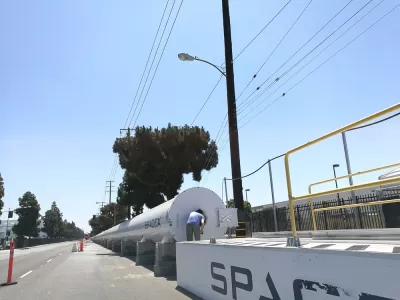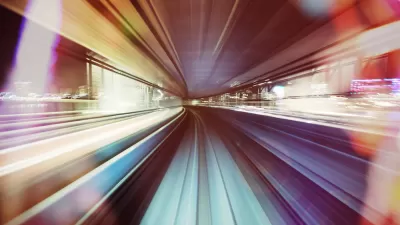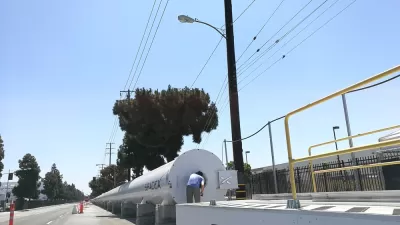A feasibility analysis published today estimates costs and benefits for the still-unproven Hyperloop technology, as envisioned for a route connecting Cleveland and Chicago.

Steven Litt reports the details of a feasibility analysis of a Hyperloop connecting Cleveland to Chicago, published today by the Northeast Ohio Areawide Coordinating Agency (NOACA) and the Los Angeles-based Hyperloop Transportation Technologies.
"A high-speed hyperloop line that could zoom passengers through a vacuum tube from Cleveland to Chicago and Pittsburgh could cost from $24.7 billion to $29.8 billion to build, depending on variations in the route and stops along the way," explains Litt of the findings included in the feasibility analysis.
NOACA Executive Director Grace Gallucci is quoted extensively in the article explaining that the impetus for the study and the project is coming from the private sector, which would be expected to pay most of the costs of any project.
"NOACA’s not trying to push this," says Gallucci in the article. "NOACA wants to be part of the innovation and a leader, but that’s very different from pushing it. This is not our agenda."
The article includes details on how the technology is expected to work, along with data on the jobs and economic benefit the project's construction could deliver to the region's along the Cleveland to Chicago route.
FULL STORY: Cleveland hyperloop benefits would justify $29.8 billion price tag: study

Study: Maui’s Plan to Convert Vacation Rentals to Long-Term Housing Could Cause Nearly $1 Billion Economic Loss
The plan would reduce visitor accommodation by 25,% resulting in 1,900 jobs lost.

North Texas Transit Leaders Tout Benefits of TOD for Growing Region
At a summit focused on transit-oriented development, policymakers discussed how North Texas’ expanded light rail system can serve as a tool for economic growth.

Why Should We Subsidize Public Transportation?
Many public transit agencies face financial stress due to rising costs, declining fare revenue, and declining subsidies. Transit advocates must provide a strong business case for increasing public transit funding.

How to Make US Trains Faster
Changes to boarding platforms and a switch to electric trains could improve U.S. passenger rail service without the added cost of high-speed rail.

Columbia’s Revitalized ‘Loop’ Is a Hub for Local Entrepreneurs
A focus on small businesses is helping a commercial corridor in Columbia, Missouri thrive.

Invasive Insect Threatens Minnesota’s Ash Forests
The Emerald Ash Borer is a rapidly spreading invasive pest threatening Minnesota’s ash trees, and homeowners are encouraged to plant diverse replacement species, avoid moving ash firewood, and monitor for signs of infestation.
Urban Design for Planners 1: Software Tools
This six-course series explores essential urban design concepts using open source software and equips planners with the tools they need to participate fully in the urban design process.
Planning for Universal Design
Learn the tools for implementing Universal Design in planning regulations.
City of Santa Clarita
Ascent Environmental
Institute for Housing and Urban Development Studies (IHS)
City of Grandview
Harvard GSD Executive Education
Toledo-Lucas County Plan Commissions
Salt Lake City
NYU Wagner Graduate School of Public Service




























